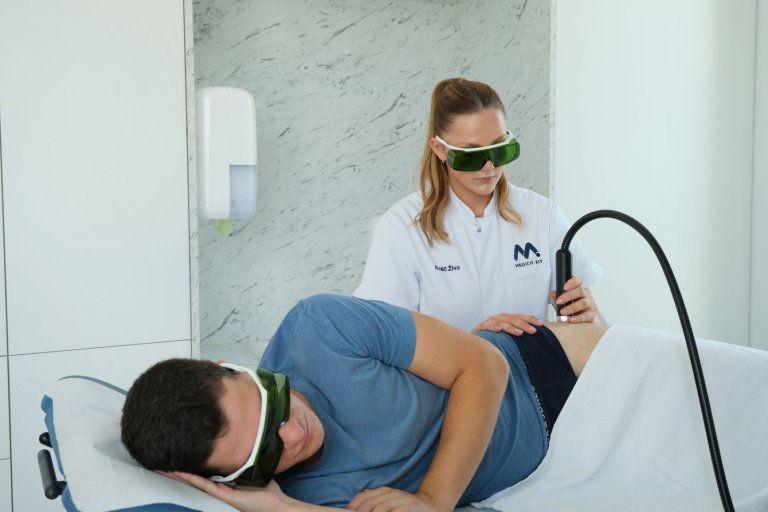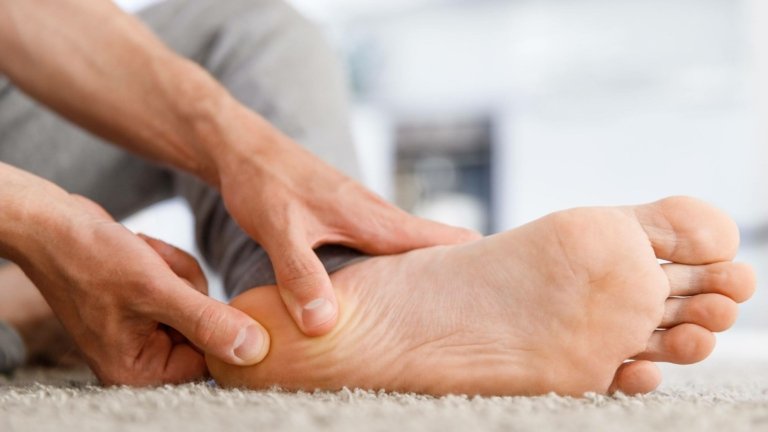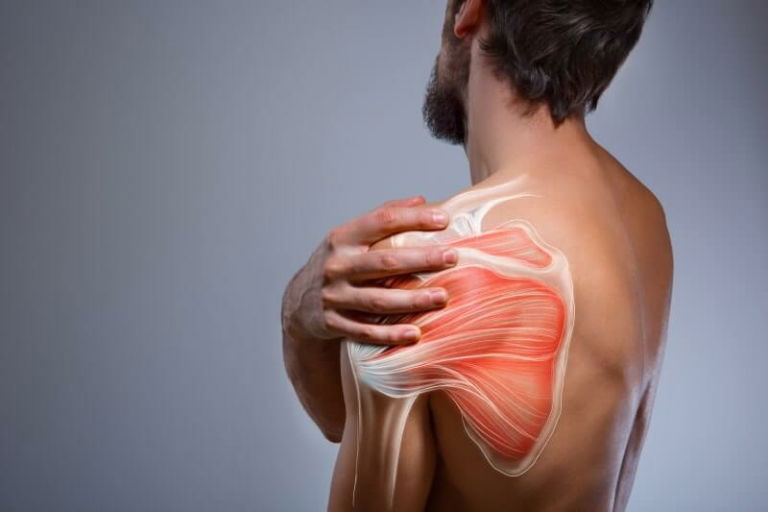Ali ste kdaj občutili nenadno bolečino v zadnjici, ki se širi po nogi? Ste pomislili, da je morda kriv išias? Intenzivno bolečino v zadnjici, ki se širi navzdol po nogah pogosto povezujemo s težavami, ki izvirajo iz hrbtenice. V ozadju teh simptomov se pogosto skriva manj znan, a zelo resen problem – piriformis sindrom.
Intense pain in the buttocks that radiates down the legs is often associated with problems originating in the spine, such as a herniated disc. Behind these symptoms often lies a lesser-known, but very serious problem – piriformis syndrome.
The syndrome is more common than you might think and can cause serious problems if not treated promptly and correctly.
Piriformis syndrome affects approximately 10% of people who suffer from low back pain. However, it is often misdiagnosed, which can lead to long-term pain and limited mobility.
Without correct rehabilitation and treatment, this syndrome can cause permanent nerve damage, chronic pain, and movement limitation.
MEDICOFIT specialist physiotherapy focuses on accurate diagnosis and comprehensive treatment of piriformis syndrome. With individually tailored rehabilitation programmes and expertly guided training, we help you regain mobility and reduce pain.
Book an appointment for piriformis syndrome rehabilitation
What is piriformis syndrome?
Piriformis syndrome is difficult to diagnose, as it often has the same symptomatic picture as sciatica, which originates in spinal problems. Sciatica is a result of lumbar spine dysfunction, such as nerve compression caused by a herniated disc, spinal stenosis, or osteoarthritis.

Piriformis syndrome occurs when the deep gluteal muscle, the piriformis muscle, spasms and compresses the sciatic nerve (sciatica), which lies directly beneath it. Piriformis syndrome is thus a compression of the sciatic nerve (sciatic nerve) caused by the piriformis muscle.
Piriformis syndrome is pain that radiates from the buttocks and spreads down the back of the thigh with possible distal symptoms to the foot. In a severe acute form, piriformis syndrome can also radiate to the lumbar spine region, but it is most intense in the hip area.
One of the characteristics is that direct pressure on the piriformis muscle worsens the pain symptoms, with sitting on hard surfaces being especially unbearable. Piriformis syndrome is also aggravated by increased activation of the deep gluteal muscles, such as prolonged standing or intense lower limb training, cycling, and even walking in the acute phase.
A severe, acute condition of piriformis syndrome is also characterised by limited mobility in the hip, tingling, and sensory numbness in the buttock area.
Bilateral asymmetry in the strength of hip abduction and external rotation is also characteristic, or the affected side will be limited by pain in muscle activation of the gluteal muscle groups.
Understanding the anatomy and function of the piriformis muscle and sciatic nerve is key to distinguishing between discogenic sciatica and piriformis syndrome.
How does the piriformis muscle work?
The piriformis muscle is a muscle of the deep gluteal musculature, located directly under the gluteus maximus muscle. The deep gluteal muscles are piriformis, obturator internus, quadratus femoris, gemellus superior, and gemellus inferior.
The piriformis muscle is the most superficial muscle of the deep gluteal muscle group and represents a sensitive anatomical area, passing through the greater sciatic foramen in the pelvis, with the sciatic nerve entering directly below it.
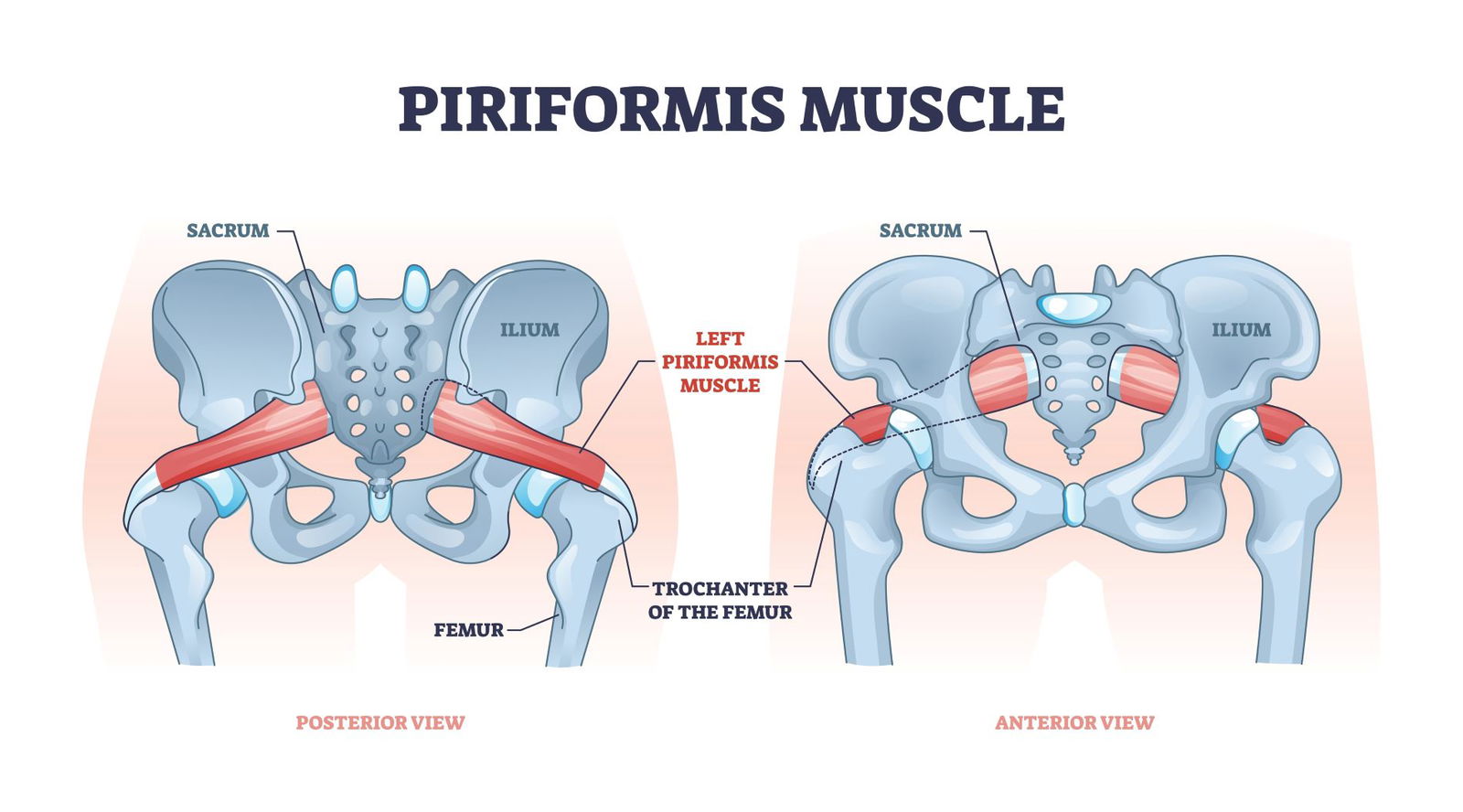
Did you know that the sciatic nerve is located only 1.5 to 3 centimetres away from the piriformis muscle on average, and less than 0.9 centimetres in certain anatomical variations?
The piriformis muscle is a deep lateral stabiliser of the hip joint, primarily performing external rotation of the hip, but also assisting in abduction, extension, internal rotation, and hip flexion. The function of the piriformis muscle is to stabilise the pelvis during rotational loads in synergy with the other deep gluteal muscles.
Pseudoscience often incorrectly explains that the piriformis muscle needs to be strengthened to ensure better stabilisation of the pelvis, for example in connection with loads when running. The piriformis muscle actually functions as “reserve fuel” or backup; primary stabilisation and high load-bearing is performed by the large muscle groups of the hip, the gluteus maximus and the gluteus medius.
As part of the rehabilitation of piriformis syndrome, we primarily need to adequately strengthen the main muscle groups of the hip, and to treat the piriformis muscle with painkillers and anti-inflammatory medication.
What symptoms does piriformis syndrome cause?
Piriformis syndrome is characterised by severe pain in the buttock area, which more often occurs on one side than on both, and the pain can radiate down the leg to the foot. Distal pain in piriformis syndrome runs down the back of the thigh.
WHEN TO OPT FOR MEDICOFIT DIAGNOSTIC THERAPY?
- Persistent pain in the buttocks that spreads into one or both legs.
- Presence of neurological symptoms such as weakness, numbness, or tingling in the legs.
- If you have previously experienced problems with pain and the symptoms are recurring, this means that the condition was not properly treated.
At MEDICOFIT clinic, we provide patients with scientifically supported specialist physiotherapy, which begins with booking a diagnostic therapy appointment.
At MEDICOFIT clinic, we provide patients with scientifically supported specialist physiotherapy, which begins with booking a diagnostic therapy appointment.
Book an appointment for piriformis syndrome rehabilitation
Causes of piriformis syndrome
The most common mechanism of piriformis syndrome is overloading of the piriformis muscle, which occurs as a result of poor muscle function of the large gluteal muscles.
Articles often claim that intense running can be one of the causes, but running actually involves poorer local muscle endurance of the larger gluteal muscle groups, which causes excessive activation of the piriformis muscle that otherwise primarily functions as a stabiliser.
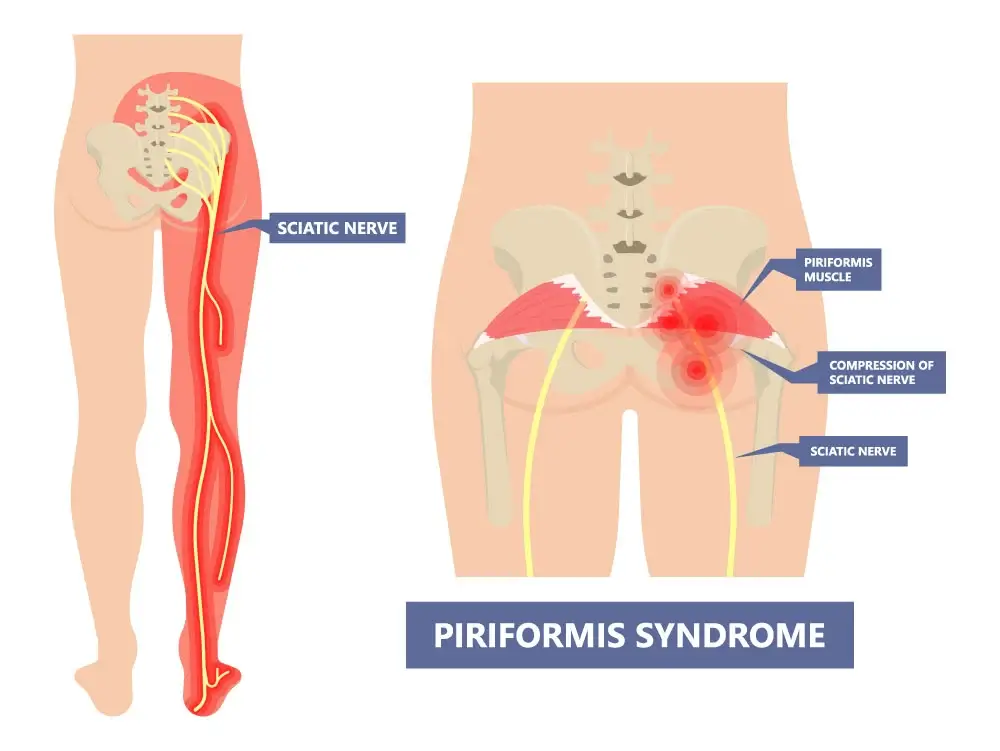
When the gluteus maximus and gluteus medius muscles “fail”, their role is taken over by the piriformis muscle, which becomes shortened and irritated or inflamed due to overuse.
Did you know that piriformis syndrome can also be caused by prolonged walking combined with improper hip mechanics due to shortened hip muscles?
The sports activity most directly associated with piriformis syndrome is cycling due to prolonged direct pressure on the piriformis area and intense repetitive load.
Overuse of the piriformis muscle can also occur directly due to increased long-term pressure on the piriformis muscle in the form of long eccentric loads or direct pressure, e.g. when sitting.
Individuals with an anatomical variation where the distance between the piriformis muscle and the sciatic nerve is shorter than 1.5 centimetres are at higher risk. Anatomical variations mean that the sciatic nerve lies in different relationships to the piriformis muscle; in fact, it can run above or below the piriformis muscle at varying distances.
Book an appointment for piriformis syndrome rehabilitation
How do we distinguish sciatica from piriformis syndrome?
Piriformis syndrome is often difficult to distinguish from sciatica, which is caused by spinal pathologies or discogenic pain. It is important that the physiotherapist performs differential clinical testing and gradually eliminates all possible causes of sciatic symptoms at the spinal level.
The basic understanding of the clinical picture of sciatica and piriformis syndrome is often only superficial in practice. Piriformis syndrome is not accompanied by low back pain, or the pain is only present when there is a strong, acute irritation, and patients can easily identify that the pain originates in the hip area.
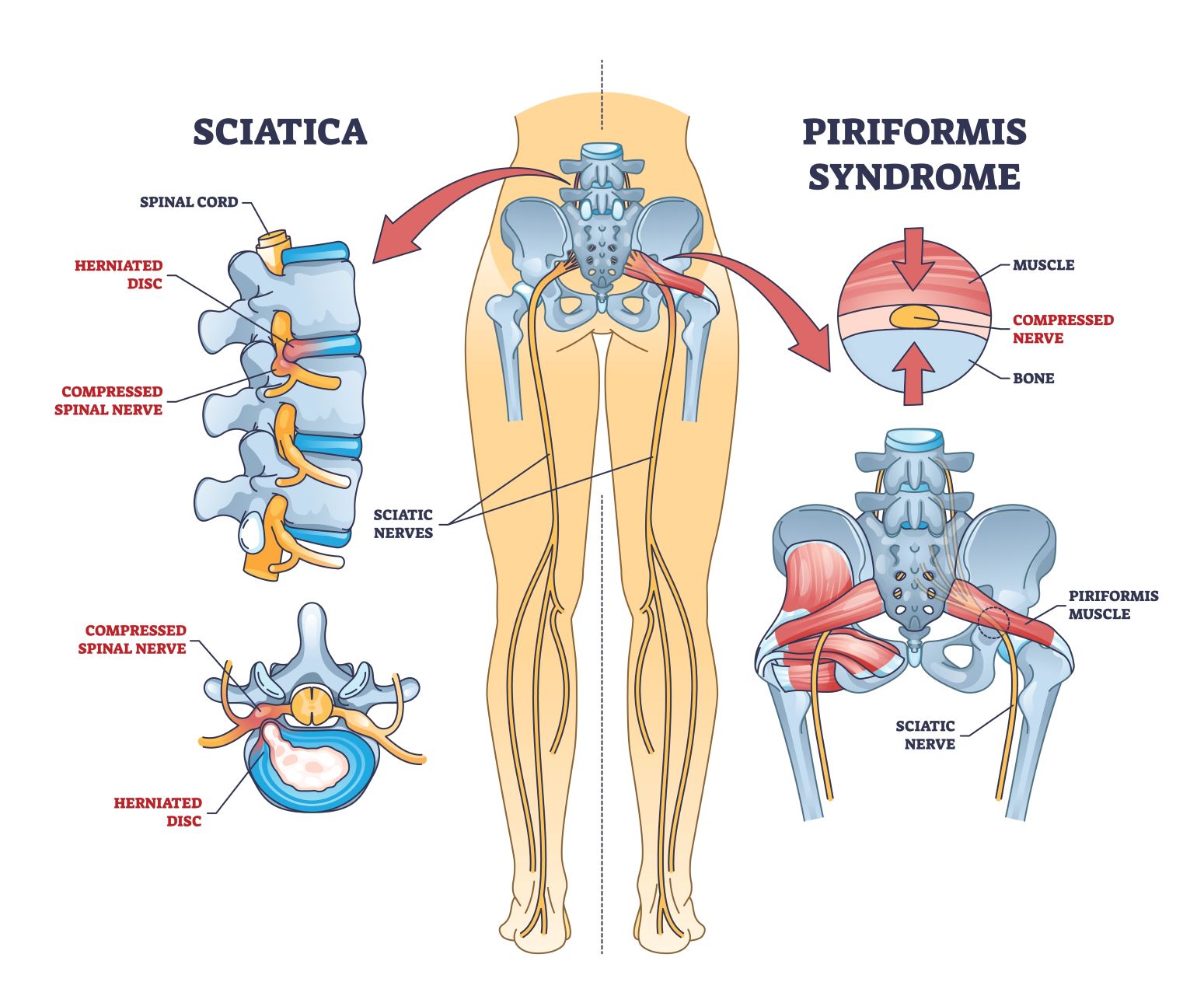
However, we must be aware that the mere absence of low back pain is not enough to diagnose piriformis syndrome, as sciatica can also manifest in various forms, e.g. with complete absence of low back pain or lumbar spine pain, which may be present only in the gluteal region or only distally in the ankle area or throughout the entire lower extremity without radiating to the lumbar spine.
At MEDICOFIT clinic, if we suspect piriformis syndrome, we perform diagnostic therapy, testing direct palpation of the piriformis area and simultaneously taking a detailed history of pain in the low back, hip, and lower extremities.
We must be aware that in rare cases of spinal compression of the sciatic nerve, there may also be a complete absence of back pain in the past or a case of sciatica with an asymptomatic spine.
It is important for clinical diagnosis to be performed by a properly trained physiotherapist who will be accurate in the direct palpation test of the piriformis. We know from clinical practice that in the case of piriformis syndrome, direct palpation of the piriformis muscle will show tenderness, and increasing pressure will result in greater irritation of the condition.
WHY CHOOSE SPECIALIST PHYSIOTHERAPY TREATMENT?
- We ensure high treatment success and guarantee long-term health of the spine.
- Up to 95% of our patients do not require spinal surgery!
- We offer state-of-the-art non-invasive treatment methods that provide optimal conditions for complete resolution of piriformis syndrome symptoms.
Comprehensive treatment of piriformis syndrome at MEDICOFIT clinic is recommended by numerous renowned orthopaedic surgery specialists.
It is important that the physiotherapist performs all clinical tests for neurological compression at the level of the lumbar spine and also performs a spinal load test for the appropriate differential diagnosis of piriformis syndrome.
After diagnostic therapy, specialised physiotherapy for piriformis syndrome is performed at MEDICOFIT clinic.
Treatment of piriformis syndrome
In the initial acute phase of an irritated piriformis muscle, we perform neurodynamic exercises for the sciatic nerve and take care not to increase pressure on the nerve with treatment methods.
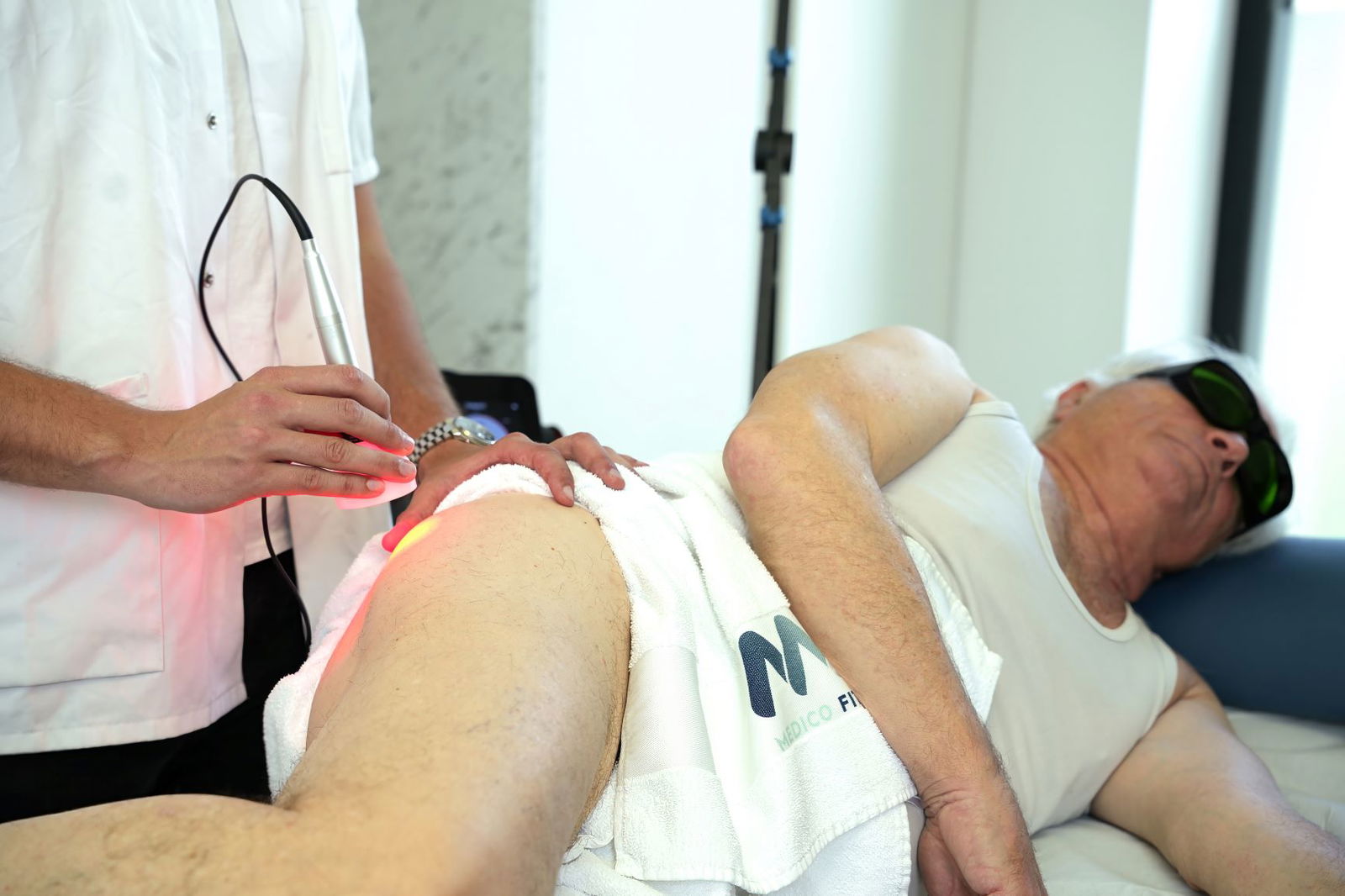
Aggressive trigger point therapy is contraindicated in the acute phase, as is forced stretching, as both can worsen the irritated condition. We perform TECAR therapy and laser therapy to reduce pain or irritation of the condition. Once symptoms improve, we begin manual techniques and exercises to achieve optimal mobility of the hip joint.
The key to piriformis syndrome is building adequate load-bearing capacity in the hip in the form of increasing strength endurance of the gluteus maximum and gluteus medius muscle groups. It is also important that movement patterns at the end of rehabilitation are appropriate, without any compensatory movements or muscle deficits.
DANGERS AND PITFALLS OF DELAYED REHABILITATION

MEDICOFIT specialists
- Chronic irritation of the sciatic nerve can cause permanent changes in nerve tissue, which can lead to long-term neuropathy.
- Reduced mobility and flexibility due to untreated muscle dysfunction can lead to secondary problems such as changes in gait and posture.
- Long-term incorrect biomechanics can lead to secondary problems such as degenerative changes in the joints and spine.
Inadequate or delayed rehabilitation seriously jeopardises an individual’s long-term physical health and is the main culprit for unsuccessful results and permanent movement limitations.
In athletes, we perform full hip loading in a closed kinetic chain and sport-specific testing.
How long does treatment last?
Comprehensive treatment lasts between four and six weeks to achieve all rehabilitation goals. Every patient must understand that eliminating the pain of piriformis syndrome is only the first phase of treatment, while restoring full motor function and optimal function of movement patterns represents the norm for completing rehabilitation in the second phase of treatment.
In cases where it is a chronic condition or a long-term severely irritated condition, rehabilitation can take up to 10 weeks.
Is muscle stretching appropriate?
Few fields of pain rehabilitation and physiotherapy contain the dimensions of pseudoscience that arise in relation to conditions such as piriformis syndrome, sciatica, and low back pain. Piriformis syndrome is a condition that is often caused in combination with dysfunction of the gluteal muscles.
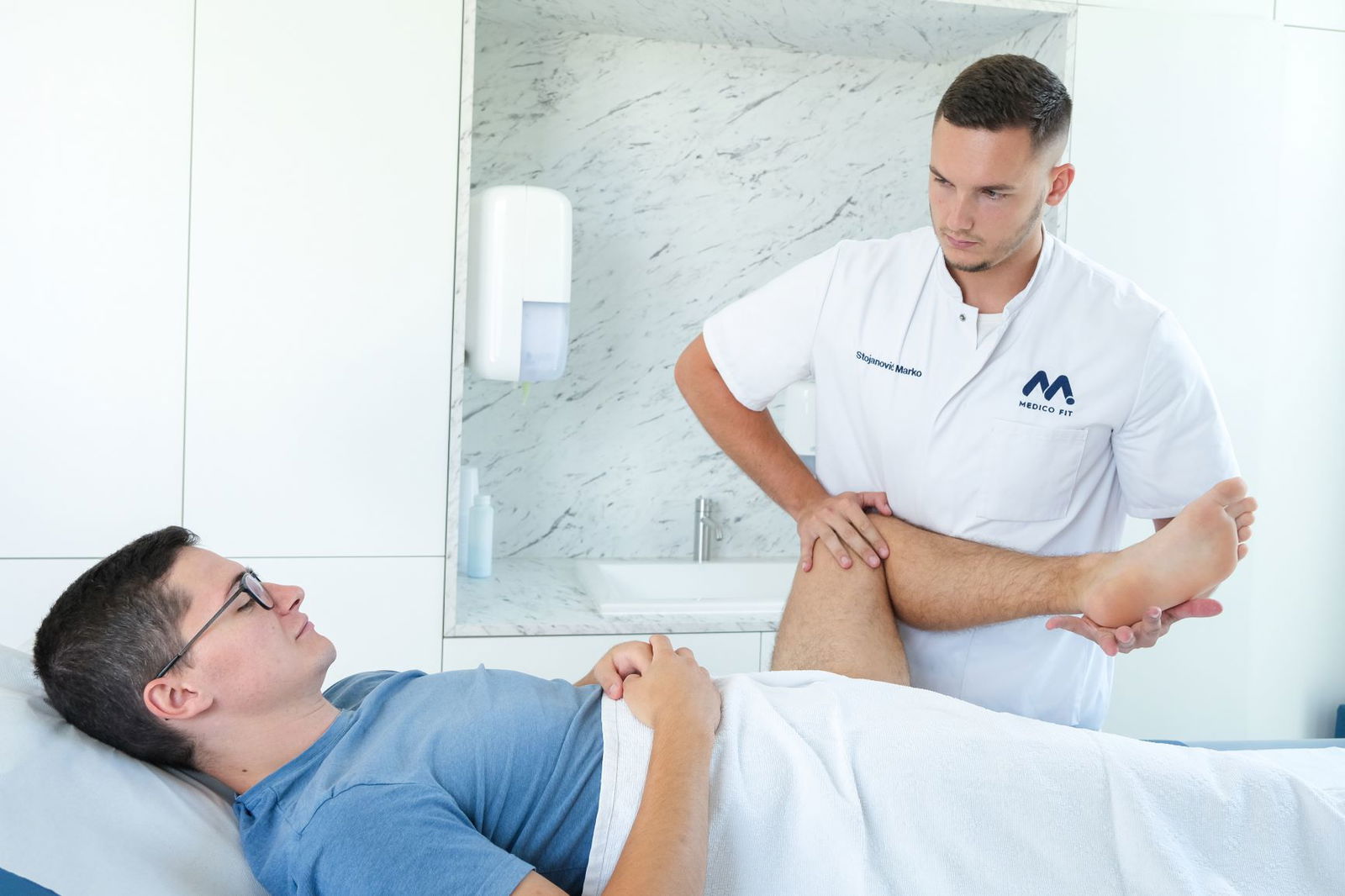
The most common advice for piriformis syndrome has become myofascial release in the form of foam rolling and piriformis stretching, which often involve exercises that increase direct pressure on the piriformis. These are quick fixes that are not aimed at comprehensive treatment and can lead to chronic piriformis syndrome.
Piriformis syndrome is a condition that has a difficult path to diagnosis, which must be differential, specifically with clinical tests, a detailed anamnesis, palpation tests, and muscle strength tests.
You may have piriformis syndrome when you experience chronic pain in your buttocks or severe acute pain in the back or outer side of your hip that radiates down one or both legs.
Such cases involve compression of the sciatic nerve, which is the longest and thickest nerve in our body and innervates our lower extremities. Sciatic nerve compression can be discogenic at the spinal level or myofascial caused by the piriformis muscle.
Book an appointment for piriformis syndrome rehabilitation








